Related Research Articles

The Hebrew term Abaddon, and its Greek equivalent Apollyon appear in the Bible as both a place of destruction and an angel of the abyss. In the Hebrew Bible, abaddon is used with reference to a bottomless pit, often appearing alongside the place Sheol, meaning the resting place of dead peoples.
The Book of Exodus is the second book of the Bible. It is a narrative of the Exodus, the origin myth of the Israelites leaving slavery in Biblical Egypt through the strength of their deity named Yahweh, who according to the story chose them as his people. The Israelites then journey with the legendary prophet Moses to Mount Sinai, where Yahweh gives the 10 commandments and they enter into a covenant with Yahweh, who promises to make them a "holy nation, and a kingdom of priests" on condition of their faithfulness. He gives them their laws and instructions to build the Tabernacle, the means by which he will come from heaven and dwell with them and lead them in a holy war to conquer Canaan, which has earlier, according to the myth of Genesis, been promised to the "seed" of Abraham, the legendary patriarch of the Israelites.
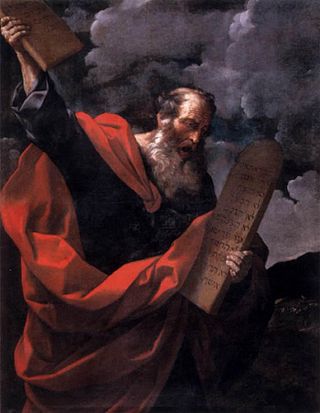
Moses was a Hebrew teacher and leader considered the most important prophet in Judaism and one of the most important prophets in Christianity, Islam, the Baháʼí Faith, and other Abrahamic religions. According to both the Bible and the Quran, Moses was the leader of the Israelites and lawgiver to whom the prophetic authorship of the Torah is attributed.

Yahweh was an ancient Levantine deity, and national god of the Israelite kingdoms of Israel and Judah. Though no consensus exists regarding the deity's origins, scholars generally contend that Yahweh is associated with Seir, Edom, Paran and Teman, and later with Canaan. The origins of his worship reach at least to the early Iron Age, and likely to the Late Bronze Age, if not somewhat earlier.

Baal, or Baʻal, was a title and honorific meaning 'owner' or 'lord' in the Northwest Semitic languages spoken in the Levant during antiquity. From its use among people, it came to be applied to gods. Scholars previously associated the theonym with solar cults and with a variety of unrelated patron deities, but inscriptions have shown that the name Ba'al was particularly associated with the storm and fertility god Hadad and his local manifestations.
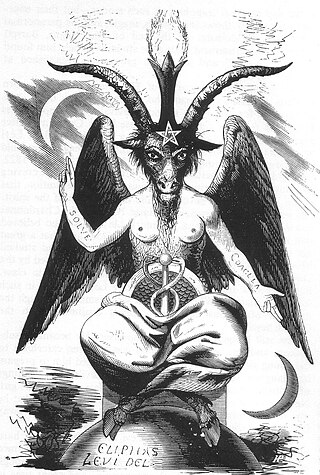
Baphomet is a deity which the Knights Templar were accused of worshipping that subsequently became incorporated into various occult and Western esoteric traditions. The name Baphomet appeared in trial transcripts for the Inquisition of the Knights Templar starting in 1307. It first came into popular English usage in the 19th century during debate and speculation on the reasons for the suppression of the Templar order. Baphomet is a symbol of balance in various occult and mystical traditions, the origin of which some occultists have attempted to link with the Gnostics and Templars, although occasionally purported to be a deity or a demon. Since 1856 the name Baphomet has been associated with the "Sabbatic Goat" image drawn by Éliphas Lévi, composed of binary elements representing the "symbolization of the equilibrium of opposites": half-human and half-animal, male and female, and good and evil. Lévi's intention was to symbolize his concept of balance, with Baphomet representing the goal of perfect social order.
Monolatry is the belief in the existence of many gods, but with the consistent worship of only one deity. The term monolatry was perhaps first used by Julius Wellhausen.

Mūsā ibn ʿImrān is a prominent prophet and messenger of God and is the most frequently mentioned individual in the Quran, with his name being mentioned 136 times and his life being narrated and recounted more than that of any other prophet. He is one of the most important prophets and messengers of Islam.

Mohammedan is a term for a follower of Muhammad, the Islamic prophet. It is used as both a noun and an adjective, meaning belonging or relating to, either Muhammad or the religion, doctrines, institutions and practices that he established. The word was formerly common in usage, but the terms Muslim and Islamic are more common today. Though sometimes used stylistically by some Muslims, a vast majority consider the term archaic or a misnomer.
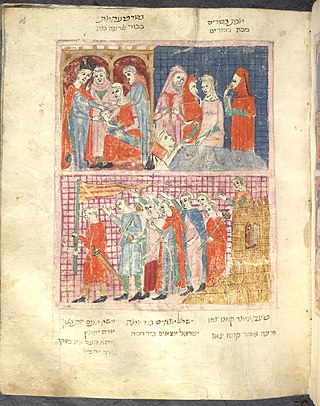
The Plagues of Egypt, in the account of the Book of Exodus, are ten disasters inflicted on biblical Egypt by the God of Israel (Yahweh) in order to convince the Pharaoh to emancipate the enslaved Israelites, each of them confronting Pharaoh and one of his Egyptian gods; they serve as "signs and marvels" given by God to answer Pharaoh's taunt that he does not know Yahweh: "The Egyptians shall know that I am the LORD". The Ten Plagues are recited during the Passover Seder.
Yunus, is the 10th chapter (surah) of the Quran with 109 verses (ayat). Yunus is named after the prophet Yunus (Jonah). According to tafsir chronology, it is believed to have been revealed before the migration of the Islamic prophet Muhammed and his followers from Mecca to Medina (Hijra), as such, it is known as a Meccan surah.
An-Naml is the 27th chapter (sūrah) of the Qur'an with 93 verses (āyāt).

The Exodus is the founding myth of the Israelites whose narrative is spread over four of the five books of the Pentateuch.
Richard Elliott Friedman is an American biblical scholar, theologian, and translator who currently serves as the Ann and Jay Davis Professor of Jewish Studies at the University of Georgia.
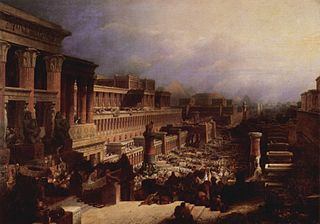
Bo is the fifteenth weekly Torah portion in the annual Jewish cycle of Torah reading and the third in the book of Exodus. The parashah constitutes Exodus 10:1–13:16. The parashah tells of the last three plagues on Egypt and the first Passover.
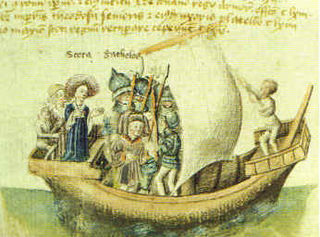
In medieval Irish and Scottish legend, Goídel Glas is the creator of the Goidelic languages and eponymous ancestor of the Gaels. The tradition can be traced to the 11th-century Lebor Gabála Érenn. A Scottish variant is recorded by John of Fordun.

Jewish mythology is the body of myths associated with Judaism. Elements of Jewish mythology have had a profound influence on Christian mythology and on Islamic mythology, as well as on Abrahamic culture in general. Christian mythology directly inherited many of the narratives from the Jewish people, sharing in common the narratives from the Old Testament. Islamic mythology also shares many of the same stories; for instance, a creation-account spaced out over six periods, the legend of Abraham, the stories of Moses and the Israelites, and many more.

Exodus is the title given to an Old English alliterative poem in the 10th century Junius manuscript. Exodus is not a paraphrase of the biblical book, but rather a re-telling of the story of the Israelites' flight from Egyptian captivity and the Crossing of the Red Sea in the manner of a "heroic epic", much like Old English poems Andreas, Judith, or even Beowulf. It is one of the densest, most allusive and complex poems in Old English, and is the focus of much critical debate.

In Islam, Hārūn ibn ʿImrān, the Biblical Aaron, is a prophet and messenger of God, and the older brother of the prophet Mūsā (Moses). He along with his brother (Moses) preached the Israelites to the Exodus.

Biblical Egypt, or Mizraim, is a theological term used by historians and scholars to differentiate between Ancient Egypt as it is portrayed in Judeo-Christian texts and what is known about the region based on archaeological evidence. Along with Canaan, Egypt is one of the most commonly mentioned locations in the Bible, and its people, the Egyptians, play important roles in the story of the Israelites. Although interaction between Egypt and nearby Semitic-speaking peoples is attested in archaeological sources, they do not otherwise corroborate the biblical account.
References
- ↑ "Mahound" . Oxford English Dictionary (Online ed.). Oxford University Press.(Subscription or participating institution membership required.) Other spellings include Macon (for example, in Orlando Furioso ) and Mahun (for example, in Cursor Mundi ).
- ↑ Esposito, John L. (1999). The Islamic threat : myth or reality? (3rd ed.). New York, NY: Oxford Univ. Press. p. 250. ISBN 0-19-513076-6.
Mahound.
- ↑ Annemarie Schimmel, Islam: An Introduction, 1992.
- ↑ William Montgomery Watt,Muhammad: Prophet and Statesman, Oxford University Press, 1961, p. 229
- ↑ Juferi, Mohd Elfie Nieshaem (September 20, 2005). "The Christian Missionaries & Their Lies About Muhammad". Bismika Allahuma. Retrieved November 14, 2023.
- ↑ Bernard Lewis (2002), p. 45.
- ↑ Barber, Malcolm, The NewKnighthood: A History of the Order of the Temple, Cambridge University Press, 1994, p. 321.
- ↑ N-Town Cycle: The Death of Judas, and the Trials of Christ Before Pilate and Herod Archived 2008-07-04 at the Wayback Machine , line 165.
- ↑ The York Cycle: The Israelites in Egypt, the Ten Plagues, and Passage of the Red Sea Archived 2008-07-24 at the Wayback Machine , line 404.
- ↑ The Nuttall Encyclopedia: Mahoun.
- ↑ Robert Burns, The Deil's Awa Wi' Th' Exciseman.
- ↑ G. K. Chesterton, Lepanto.
- ↑ Valinora Troy's Review of Child of the Moon